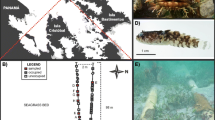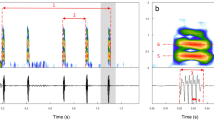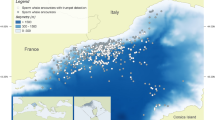Abstract
Acoustic signals and associated behaviours of a number of fishes in the genus Cyprinella have been investigated and described in detail, but due to logistics, these studies have been done in the laboratory. We used C. venusta as a model for evaluating potential differences in acoustic signals in field versus laboratory settings. In addition to this analysis, a detailed description of acoustic signals and associated behaviours was produced. We found that males were the only sex to vocalize and did so during reproductively associated behaviours such as courtship, aggression, and spawning. Sounds were similar in gross structure to most other species of Cyprinella in that they were composed of bursts and knocks, but differed in a number of signal parameters including acoustic frequency, pulse duration, pulse period, and pulse rate. One of the more striking findings was that the acoustic frequency distributions of both growls and knocks in C. venusta were bi-modal, a characteristic not mentioned for any other species in the genus Cyprinella. Sounds recorded in the laboratory were also found to be significantly different from those recorded in the field.



Similar content being viewed by others
References
Aiken RB (1985) Sound production by aquatic insects. Biol Rev 60:163–211
Akamatsu T, Okumura T, Novarini N, Yan HY (2002) Empirical refinements applicable to the recording of fish sounds in small tanks. J Acoust Soc Am 112:3073–3082
Amorim MCP, Fonseca PJ, Almada VC (2003) Sound production during courtship and spawning of Oreochromis mossambicus: male-female and male-male interactions. J Fish Biol 62:658–672
Ballantyne PK, Colgan PW (1978) Sound production during agonistic and reproductive behaviour in the pumpkinseed (Lepomis gibbosus), the bluegill (Lepomis macrochirus), and their hybrid sunfish. II. Response. Biol Behav 3:221–292
Bonga SEW (1997) The stress response in fish. Physiol Rev 77:591–625
Boschung HT Jr, Mayden RL (2004) Fishes of Alabama. Smithsonian Books, Washington, DC
Bradbury JW, Vehrencamp SL (1998) Principles of animal communication. Sinauer, Sunderland
Brawn VM (1961) Sound production by the cod (Gadus callarias L.). Behaviour 18:239–255
Colson DJ, Patek SN, Brainerd EL, Lewis SM (1998) Sound production during feeding in hippocampus seahorses (Syngnathidae). Environ Biol Fish 51:221–229
Connaughton MA, Fine ML, Taylor MH (2002) Weakfish sonic muscle: influence of size, temperature and season. J Exp Biol 205:2183–2188
Crawford JD, Hagedorn M, Hopkins CD (1986) Acoustic communication in an electric fish, Pollimyrus isidori (Mormyridae). J Comp Physiol A 159:297–310
Delco EA (1960) Sound discrimination by males of two cyprinid fishes. Tex J Sci 12:48–54
Demski LS, Gerald JW, Popper AN (1973) Central and peripheral mechanisms of Teleost sound production. Am Zool 13:1141–1167
Dooling RJ, Lohr B, Dent ML (2000) Hearing in birds and reptiles. In: Dooling RJ, Fay RR, Popper AN (eds) Comparative hearing: Birds and reptiles. Springer, New York, pp 308–359
Drewry CE (1962) Some observations of courtship behaviour and sound production in five species of Fundulus. Masters Thesis, University of Texas at Austin
Fay RR (1985) Temporal processing by the auditory system of fishes. In: Michelsen A (ed) Time resolution in auditory systems. Springer, Berlin, pp 28–57
Fine ML, Winn HE, Olla BL (1977) Communication in fishes. In: Sebeok TA (ed) How animals communicate. Indiana University Press, Bloomington, pp 472–518
Gray GA, Winn HE (1961) Reproductive Ecology and sound production of the toadfish, Opsanus tau. Ecology 42:247–282
Hawkins AD, Amorim MCP (2000) Spawning sounds of the male haddock, Melanogrammus aeglefinus. Environ Biol Fish 59:29–41
Janik VM (2005) Underwater acoustic communication networks in marine mammals. In: McGregor PK (ed) Animal communication networks. University Press, Cambridge, pp 390–415
Johnston CE (1999) The relationship of spawning mode to conservation of North American minnows (Cyprinidae). Environ Biol Fish 55:21–30
Johnston CE, Johnson DL (2000a) Sound production during the spawning season in cavity-nesting darters of the subgenus Catonotus (Percidae: Etheostoma). Copeia 2000:475–481
Johnston CE, Johnson DL (2000b) Sound production in Pimephales notatus (Rafinesque) (Cyprinidae). Copeia 2000:567–571
Johnston CE, Vives SP (2003) Sound production in Codoma ornate (Girard) (Cyprinidae). Environ Biol Fish 68:81–85
Kaatz IM, Lobel PS (2001) A comparison of sounds recorded from a catfish (Orinocodoras eigenmanni, Doradidae) in an aquarium and in the field. Biol Bull 201:278–280
Ladich F (2004) Sound production and acoustic communication. In: Von der Emde G, Mogdans J, Kapoor BG (eds) The senses of fish adaptations for the reception of natural stimuli. Narosa Publishing House, New Delhi, pp 210–230
Ladich F, Myrberg AA Jr (2006) Agonistic behaviour and acoustic communication. In: Ladich F, Collin SP, Moller P, Kapoor BG (eds) Communication in fishes, Vol. 1. Science Publishers, Enfield, pp 122–148
Ladich F, Yan HY (1998) Correlation between auditory sensitivity and vocalization in anabantoid fishes. J Comp Physiol A 182:737–746
Lin YC, Mok HK, Huang BQ (2007) Sound characteristics of big-snout croaker, Johnius macrorhynus (Sciaenidae). J Acoust Soc Am 121:586–593
Lobel PS (1992) Sounds produced by spawning fish. Environ Biol Fish 33:351–358
Lugli MP, Torricelli P (1999) Prespawning sound production in Mediterranean sand-gobies. J Fish Biol 54:691–694
Lugli MP, Pavan G, Torricelli P, Bobbio L (1995) Spawning vocalizations in male freshwater gobiids (Pices, Gobiidae). Environ Biol Fish 43:219–231
Mann DA, Lobel PS (1997) Propagation of damselfish (Pomacentridae) courtship sounds. J Acoust Soc Am 101:3783–3791
McComb K, Reby D (2005) Vocal communication networks in large terrestrial mammals. In: McGregor PK (ed) Animal communication networks. University Press, Cambridge, pp 372–389
Myrberg AA Jr, Spires JY (1972) Sound discrimination by the bicolor damselfish, Eupomacentrus partitus. J Exp Biol 57:727–735
Myrberg AA Jr, Spanier E, Ha SJ (1978) Temporal patterning in acoustic communication. In: Reese ES, Lighter FJ (eds) Contrasts in behaviour. Wiley, New York, pp 137–179
Narins PM, Feng AS, Fay RR, Popper AN (2007) Hearing and sound communication in Amphibians. Springer, New York
Nelson JS (2006) Fishes of the world, 4th edn. Wiley, New Jersey
Penteriani V (2003) Breeding density affects the honesty of bird vocal displays as possible indicators of male/territory quality. Ibis 145:127–135
Phillips CT, Johnston CE (2008) Sound production and associated behaviours in Cyprinella galactura. Environ Biol Fish 82:265–275
Phillips CT, Johnston CE (2009) Evolution of acoustic signals in Cyprinella: degree of similarity in sister species. J Fish Biol 74:120–132
Phillips CT, Johnston CE, Henderson AR (2010) Sound production and spawning behaviour in Cyprinella lepida, the Edwards Plateau shiner. Southwest Nat 55:129–135
Pruzsinszky I, Ladich F (1998) Sound production and reproductive behaviour of the armored catfish Corydoras paleatus (Callichthyidae). Environ Biol Fish 53:183–191
Rigley L, Muir J (1979) The role of sound production by the brown bullhead Ictalurus nebulosus. Proc Natl Acad Sci 53:132–134
Römer H (1998) The sensory ecology of acoustic communication in insects. Springer, New York
Salmon M (1967) Acoustic behaviour of the menpachi, Myripristis berndti, in Hawaii. Pac Sci 11:364–381
Slater PJB (2003) Fifty years of bird song research: a case study in animal behaviour. Anim Behav 65:633–639
Stout JF (1963) The significance of sound production during the reproductive behaviour of Notropis analostanus (Family Cyprinidae). Anim Behav 11:83–92
Stout JF (1975) Sound communication during the reproductive behaviour of Notropis analostanus (Pisces: Cyprinidae). Am Midl Nat 94:296–325
Valinski BW, Rigley L (1981) Function of sound production by the skunk loach Botia horae (Pisces, Cobitidae). Z Tierpsychol 55:162–172
Wells MM, Henry CS (1992) The role of courtship songs in reproductive isolation among populations of green lacewings of the Genus Chrysoperia (Neuroptera: Chrysopidae). Evolution 46:31–42
Winn HE (1964) The biological significance of fish sounds. In: Tavolga WN (ed) Marine bioacoustics, Vol. 2. Pergamon Press, New York, pp 213–231
Winn HE (1967) Vocal facilitation and the biological significance of toadfish sounds. In: Tavolga WN (ed) Marine bioacoustics, Vol. 2, vol 2. Pergamom Press, New York, pp 283–303
Winn HE, Stout JF (1960) Sound production by the satinfin shiner, Notropis analostanus and related fishes. Science 132:222
Winn HE, Marshall JA, Hazlett B (1964) Behaviour, diel activities, and stimuli that elicit sound production and reactions to sound in the longspine squirrelfish. Copeia 2:413–425
Acknowledgments
We would like to thank members of the Fish Biodiversity Lab at Auburn University, including K. Bolton, K. Dowling, K. Goodson, H. Haley, M. Scarbrough, and P. Noel for their help with collecting specimens and assistance in the field. This research was approved by the Auburn University Institutional Animal Care and Use Committee.
Author information
Authors and Affiliations
Corresponding author
Rights and permissions
About this article
Cite this article
Holt, D.E., Johnston, C.E. Sound production and associated behaviours in blacktail shiner Cyprinella venusta: a comparison between field and lab. Environ Biol Fish 97, 1207–1219 (2014). https://doi.org/10.1007/s10641-013-0208-5
Received:
Accepted:
Published:
Issue Date:
DOI: https://doi.org/10.1007/s10641-013-0208-5




